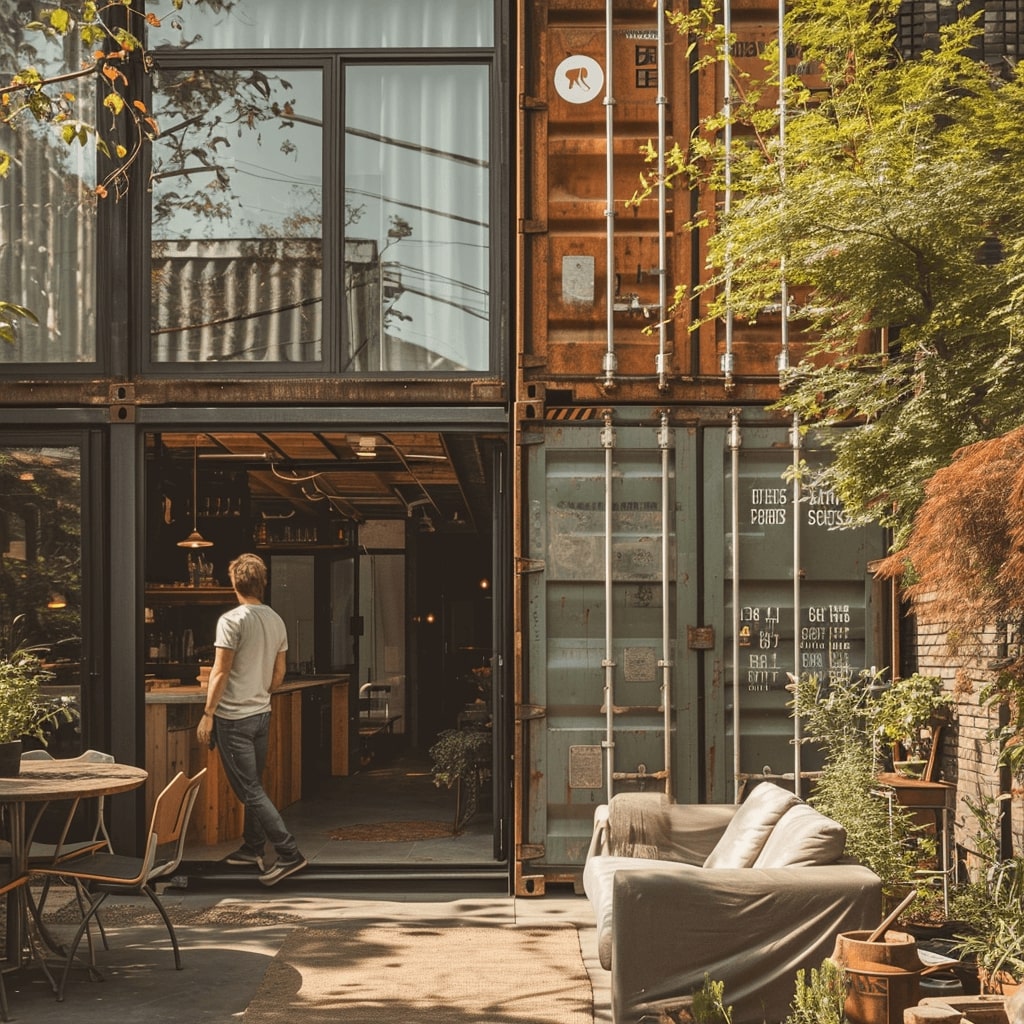Many homeowners and businesses consider the use of shipping containers for storage, as a workspace, or for various other purposes on their property. The practicality and durability of containers make them a tempting option. However, the legality of placing a shipping container on one’s property is not always straightforward.
Generally, one can store a shipping container on their property, but this is subject to local zoning laws, building codes, and, in certain instances, the need for permits.

Before proceeding with the placement of a shipping container, it is vital to be familiar with local regulations. These rules can vary significantly from one location to another.
For instance, some areas may classify containers as temporary structures, which can impact how they are regulated.
Additionally, if a shipping container is intended for use as a permanent fixture, such as a residence or office, this typically requires a more comprehensive permitting process, guided by standards such as the International Building Code.
It is also important to consider the implications of having a shipping container on private land. While in most cases it is permissible, one might face certain restrictions around the container’s placement, size, or modifications.
Consulting with local planning authorities or a legal expert can provide clarity and help ensure that all necessary steps are taken for lawful placement of a shipping container on one’s property.
Legal Considerations

Before placing a shipping container on your property, it is critical to navigate various legal considerations. This involves comprehending the zoning laws, adhering to building codes, obtaining necessary permits, engaging with local authorities, and ensuring full compliance with all regulations.
Understanding Zoning Laws
Zoning laws dictate how property within a municipality can be used. Residential zones often have different regulations compared to commercial zones. It is essential to check with your municipality’s zoning requirements to determine if a shipping container is allowed on your property. For example, some areas may have zoning regulations that prohibit the use of shipping containers in residential neighborhoods due to concerns about aesthetics or safety.
Navigating Building Codes
Building codes are in place to ensure safety and are typically guided by the International Building Code (IBC) or the International Residential Code (IRC). Your shipping container might require modifications to meet these building standards and code requirements. Failure to comply can result in fines or removal orders.
Permits and Permissions
You will likely need a building permit or a shipping container permit before installation. In some cases, a temporary use permit is required for a short-term placement. The permit requirements vary greatly, and in some municipalities, a permit expediter might be beneficial to guide you through the process.
Dealing with Local Authorities
It’s important to proactively engage with local authorities to understand any specific ordinances or restrictions. These discussions can clarify any questions and avoid potential legal issues after placement of the shipping container.
Restrictions and Compliance
Additionally, HOA rules and deed restrictions may impact the ability to use a shipping container on your property. These are particularly prevalent in planned communities and can include regulations and rules that go beyond municipal zoning laws. For those placing containers on commercial property, guidelines tend to be distinct and possibly more lenient, but still require due diligence to ensure compliance.
Preparation and Planning

Prior to placing a shipping container on one’s property, thorough preparation and planning are essential. Key considerations include legality, spatial requirements, intended use, site conditions, and safety considerations.
Evaluating Property Suitability
When considering a shipping container for backyard storage or as an office space, it’s imperative to evaluate the property’s zoning. Residential zones may have specific regulations that restrict the use of shipping containers. Understanding setback requirements and utility connections is also crucial, which dictates the distance structures must be from property lines and how the container will access necessary services.
Assessing Size and Space
Size and space are critical components in planning for a shipping container on your property. The container size must be proportionate to the available space, considering not only the footprint but also clearance for doors to open and sufficient surrounding work or storage space. Standard containers come in lengths of 20 and 40 feet, requiring a careful assessment of the allocated area.
Container Home Potential
For those exploring the potential of a shipping container as a guest house or container home, planning extends to selecting the right foundation options. Containers can be placed on simple pier foundations, concrete slabs, or more complex structures depending on the end use. Building codes pertaining to housing must be adhered to, ensuring the container is suitable for habitation.
Site Preparation
Site preparation entails levelling the ground, considering drainage, and laying the chosen foundation. Regarding transportation, adequate access must be provided for delivery trucks, and plans should be made for the container’s placement on the site. Whether it’s for a simple shed or a more permanent structure, preparing the site correctly is paramount to success.
Safety and Environmental Concerns
Identify potential hazards associated with a shipping container placement, such as being airtight which may pose ventilation issues. Adherence to safety standards ensures that the installation will not be a fire hazard or negatively impact the environment. Containers must be structurally sound and free of hazardous materials to be suitable for backyard use or dwelling.
Installation and Use

Before deploying a shipping container on a property, it’s important to recognize that installation and use vary depending on the intended purpose—be it living spaces, storage, or commercial endeavors. These adaptations will dictate the duration of installation, the interior setup including any necessary plumbing, and if the container will serve as a temporary or permanent structure.
Creating Living Spaces
When transforming a shipping container into a living space, the installation process often includes the addition of insulation, plumbing, and proper ventilation. Container homes must comply with local building codes, which might dictate the length of time the structure can remain and the specific modifications required. The interior involves comprehensive alterations for habitability, including temperature control and utility connections.
Utilizing Containers for Storage
Containers used for storage typically require less intricate installation procedures compared to living spaces. However, securing the container to prevent theft and weatherproofing are key considerations. The use as a storage shed can range in duration from temporary to long-term solutions, hinging on zoning regulations regarding the length of time a temporary structure is allowed.
Containers as Office or Commercial Space
Containers adapted for office space or commercial properties necessitate a thorough installation process. Ensuring that commercial property guidelines are met is crucial, which may involve modifications like the addition of windows, doors, and ADA-compliant access. Containers in a commercial setting often serve as a permanent structure and must therefore adhere to more stringent commercial property guidelines.
Costs and Logistics
When considering placing a shipping container on one’s property, individuals need to prepare for the financial and logistical aspects involved. These include various fees, transportation considerations, and the choice between buying or renting, as well as deciding on professional services.
Understanding Financing and Fees
Investing in a shipping container often incurs more than just the purchase price. Individuals should account for permitting fees, which vary by location but are essential for compliance with local zoning laws and building codes. Additionally, one may need to hire a permit expediter to navigate complex regulations, adding to the overall cost.
Transportation and Placement
The logistics of transportation require careful planning. The cost to deliver a shipping container includes not only the distance traveled but also the accessibility of the property. Complexities such as narrow roads or obstacles can increase fees. Ensuring a level site for placement is crucial to prevent future structural issues, which may also entail additional costs for site preparation.
Buying vs. Renting Containers
When choosing to buy a shipping container, one assumes full ownership, leading to higher upfront costs but potential long-term savings. Renting, on the other hand, offers flexibility and may be more suitable for short-term needs, with various rental rates depending on the size and condition of the container.
Utilizing Professional Services
While individuals might consider self-installation, employing professional services for the delivery and setup of a shipping container can save time and prevent costly errors. Reputable dealers often provide these services, or an independent contractor can be enlisted, ensuring the container is properly placed and secured according to local regulations.
Long-Term Considerations

When contemplating the placement of a shipping container on one’s property for the long term, it’s crucial to consider not only the immediate practicalities but also the future implications regarding maintenance, modifications, and the potential shift in property status.
Maintenance and Modification
Regular maintenance is necessary to keep a shipping container structurally sound and to maintain its safety standards. This includes inspecting for rust on the exterior, ensuring door mechanisms function properly, and repairing any breaches that could compromise the container’s integrity. When it comes to modifications, they should be done with an understanding of the container’s architecture to avoid impacting its structural integrity. For example, cutting large openings for windows or doors must be reinforced properly.
Converting to Permanent Fixtures
If a shipping container is intended to become a permanent fixture on a property, it may require a sturdy foundation and proper utility connections for electricity, water, and sewerage, akin to mobile homes or other permanent residence structures. Achieving this will often necessitate planning permission and adherence to local housing regulations, ensuring the container is suitable for permanent living or usage.
Navigating Residential Status Changes
The transition of a shipping container from a temporary structure to a recognized part of the housing inventory on a property can lead to changes in the property’s residential status. Property owners should consult local regulations, as some areas may not classify containers as permissible long-term residence solutions. Moreover, bringing a container up to code as a residential dwelling typically requires substantial modifications to meet legal and safety standards.
